Technology is now a driving force at the core of modern organizations. As emerging technologies expand exponentially, the need for technical capabilities requires a seismic shift that takes technology ownership from IT and puts it into the hands of the organization. Use this research to guide the ownership of curated technologies to leaders across your organization and expand your capacity for innovation, growth, and collaboration.
Emerging technologies have fundamentally transformed how organizations operate, making technology essential not just for IT, but for every function of the modern organization. CIOs and IT leaders must shift from gatekeepers of technology to enablers of a business-led approach, embracing a distributed ownership model that brings shadow IT into the light and enables risk-appropriate adoption of technology by leaders across departments.
1. Understand the internal appetite before you place an order.
Assuming individual leaders or your entire organization are ready to adopt an embedded technology model is the surest way to fail before you’ve begun. Embedding technology ownership across your organization requires widespread support and ongoing buy-in from leaders. Assess everyone’s readiness for a new way of operating and leverage these findings to guide your approach.
2. Build trust with your organizational leaders.
As ownership of select technologies is distributed to organizational leaders, the relationships that IT builds with these leaders become as important as technical knowledge. Leaders who suddenly own technologies without a complete understanding of internal limits or a clear line of communication with IT are less likely to successfully embrace ownership.
3. Align your initiatives with the needs of your customers.
There are infinite ways to begin embedding technology in your organization, making it difficult to prioritize where to start. Leverage your reference architecture to understand when and where customers obtain the greatest value from your organization and use this to find the most impactful opportunities to embed technology.
Use our comprehensive blueprint to design and build an embedded IT operating model for your organization.
Our research can guide the creation of a modern IT operating model suited to the needs of your organization and the demands of your customers or constituents. Remove the barriers that have historically siloed technology from the organization and distribute ownership using this in-depth blueprint with a robust set of tools and templates to:
- Assess the readiness of your organization to become more technology enabled with an Exponential IT Operating Model.
- Align your approach to how customers or constituents receive value from your organization.
- Identify opportunities to realistically embed and empower enterprise leaders to own IT capabilities.
- Communicate your plan clearly to enterprise executives to gain buy-in.
Member Testimonials
After each Info-Tech experience, we ask our members to quantify the real-time savings, monetary impact, and project improvements our research helped them achieve. See our top member experiences for this blueprint and what our clients have to say.
9.5/10
Overall Impact
$46,342
Average $ Saved
19
Average Days Saved
Client
Experience
Impact
$ Saved
Days Saved
CAF - Corporacion Andina de Fomento
Guided Implementation
10/10
$64,600
20
CAF - Corporacion Andina de Fomento
Guided Implementation
9/10
$28,085
18
Establish an Integrated Business Operating Model
Strategically embed technology capabilities to accelerate adaptability and achieve your organizational outcomes.
Introduction: What is Exponential IT?
- The technology curve has recently bent exponentially.
- Generative AI has been the catalyst for this sudden shift, but there are more and more new technologies emerging (e.g. quantum computing, 5G), putting significant pressure on all organizations.
- All IT leaders and organizations are at risk of falling behind if they do not adopt new technologies fast enough.
- Exponential IT is a framework defined by Info-Tech Research Group to instruct IT leaders across all IT domains on how to transform their organization and elevate their value creation capabilities, to close the gap between the exponential progression of technological change and the linear progression of IT's ability to successfully manage that change.
- This blueprint provides guidance on establishing integrated and dynamic risk management by evolving and autonomizing previously siloed risk capabilities and practices.
- CIOs or delegates can use this blueprint to partner with the chief risk officer or delegates in developing a roadmap to evolve the risk management capabilities of the organization.


Analyst Perspective
Enable your enterprise to deliver exceptional experiences.
For years, CIOs and IT leaders would tell me time and time again that they want to drive innovation, that they want to create exceptional services and experiences, and that they want their staff to explore emerging technologies. Excitedly, we start to explore what that would look like and mean. One of the founding elements is that the senior-most IT leader trust their organizational leaders to own the technology that drives the way they function and operate. And it is usually right at this moment that I lose them. The organizational leaders either aren't comfortable with the idea of relinquishing some of the control associated with technology capabilities or they run from those technology capabilities, throwing their hands up.
But something has changed and shifted. Organizational leaders are comfortable with technology and very aware of its impact on their function, service, or product. And CIOs want to spend their time being strategic for their organization, spending less time in the weeds of technology delivery. This seismic shift is bringing forward the need and desire to have a technology-enabled enterprise; and with that, innovation, customer-focus, and collaboration. We are starting to see a purposeful choice to remove the barriers that have historically siloed technology from the business.

Brittany Lutes
Research Director, CIO Practice
Info-Tech Research Group
Executive Summary
| Your Challenge | Common Obstacles | Info-Tech's Approach |
|
IT and organizational leaders are being forced to respond to changes in their organization, such as:
|
However, the successful evolution of these models' integration is often impeded by:
|
Our approach is to enable the organization with technology capabilities by:
|
Info-Tech Insight
Enabling adaptability, being scalable, and prioritizing customer needs in how you operate must be more than empty words and promises. It is about purposely redefining how the enterprise will operate when the entire enterprise is tech-enabled.
Technology is fundamentally changing not just what organizations can offer, but what customer or constituents expect as a service or product
- The purpose for organizations, even those in the public sector, is changing. This is requiring a greater understanding and intentional movement into new-for-your-organization business models.
- While we are more interconnected, we are also competing against more organizations to be noticed and get an increased market share.
- Customers and constituents expect seamless services or products that provide a positive experience.
- We have seen a growth in shadow IT by organizations, highlighting that they will pursue technology with or without IT's help or approval.
40% of CEOs indicated that over the past five years their companies have explored being competitive in new sectors.
Source: PwC, 2025
40% of CIOs are responsible for creating new products or services to support revenue generation.
Source: "The State of the CIO," IDG, 2023
This is being driven by external forces beyond the IT department
Driver #1: Emerging Technologies
Generative AI, agentic AI, quantum computing are some of the most influential technologies coming forward in the next three years. It's important for organizations to recognize that these emerging technologies are not just being actively adopted by them, but by their end customers and constituents.
28% of average IT organizations and 50% of transformer organizations anticipate exponential increases in value from fast-paced development technologies in 2025.
Source: Info-Tech's Tech Trends 2025 Report; n=532
Driver #2: Elevated Customer Experiences
Customers have a new set of expectations that include seamless autonomous services and exceptional experiences that are technologically dependent. Organizations need to be removing barriers between what clients want and the technology that enables those experiences.
60% of IT leaders are optimizing in aspects of the customer experience such as customer relationship management and customer service.
Source: Info-Tech's Future of IT Survey, 2024; n=466
Driver #3: Enterprise-Owned Technology Outcomes
Technology is the business. This shift requires technology to be accessible at all areas of the organization, empowering enterprise decision-makers to actively leverage and even shift business models and accommodate technology needs when appropriate.
50% of organizations have seen AI adopted by two business functions in 2024, specifically in the marketing and product and/or service development functions.
Source: McKinsey, 2024
Driver #4: Talent Optimization
IT is not the only place where the skills and abilities to deliver technology exist anymore. Instead, organizations can leverage resources throughout the enterprise to deliver on a variety of technology capabilities.
31% of IT organizations anticipate restructuring activities in 2025 that will require leveraging more business-led or embedded-IT talent.
Source: Info-Tech's IT Talent Trends 2025 Report; n=403
Every organization is watching these drivers shift the technology value trinity
Yet, we are now at a pivotal point where the influence of standards, stakeholders, and skills are shifting how each of these components can deliver their intended value.
Standards: Use standards to enable not just the IT function, but the entire organization. Leveraging usable standards provides those across the organization with the insight and authority to deliver against strategic objectives.
Stakeholders: The stakeholders that IT has historically focused on, internal end users and business function leaders, have evolved into organizational partners and the end customer or constituent. As these groups explore and use technology in new ways, understanding what those ways are will be critical to enabling and empowering those in the organization to think about that final experience.
Skills: The technical skills we need to operate effectively are consistently changing, but more importantly they are moving outside of central IT. How we democratize and leverage those skills will be important to enabling ongoing delivery of value.

Some organizations are achieving this more easily than others who get hindered by:
- The lack of collaboration and integration between IT and the business, which forces both to act in silos.
- The growing talent shortage that IT organizations are facing for critical roles in data, cloud, cybersecurity and enterprise architecture.
- Organizational leaders not held accountable for making technology-related decisions that go against enterprise standards and policies.
- IT's historic focus on the organizational partners as the customer – and not having a means or want to understand the organization's true customer or constituent.
90% of IT hiring managers report challenges finding the talent they need in today's market. Source: CIO, 2025
"I think we've done the IT industry a disservice by constantly referring to IT and the business, artificially creating this wedge."
– David Vidoni, VP of IT at Pegasystems, CIO, 2023
Successful organizations recognize that evolving means focusing on an integrated to embedded operating model

Fundamentally, how we are organized needs to move away from centralized and integrated models, where control and decision-making is kept 100% or close to 100% within the focus of a main IT function. Instead, look for ways to not only integrate IT with the organization, but to embed it. This allows for certain teams to be organizationally focused (enterprise risk and governance, anyone?), developing and managing the delivery of essential IT services, and for organization-based teams to be technology literate and capable themselves. We want all three elements of centralization in our future state models to give increased oversight on technology's growing importance in driving outcomes across the organization to internal and external stakeholders alike.
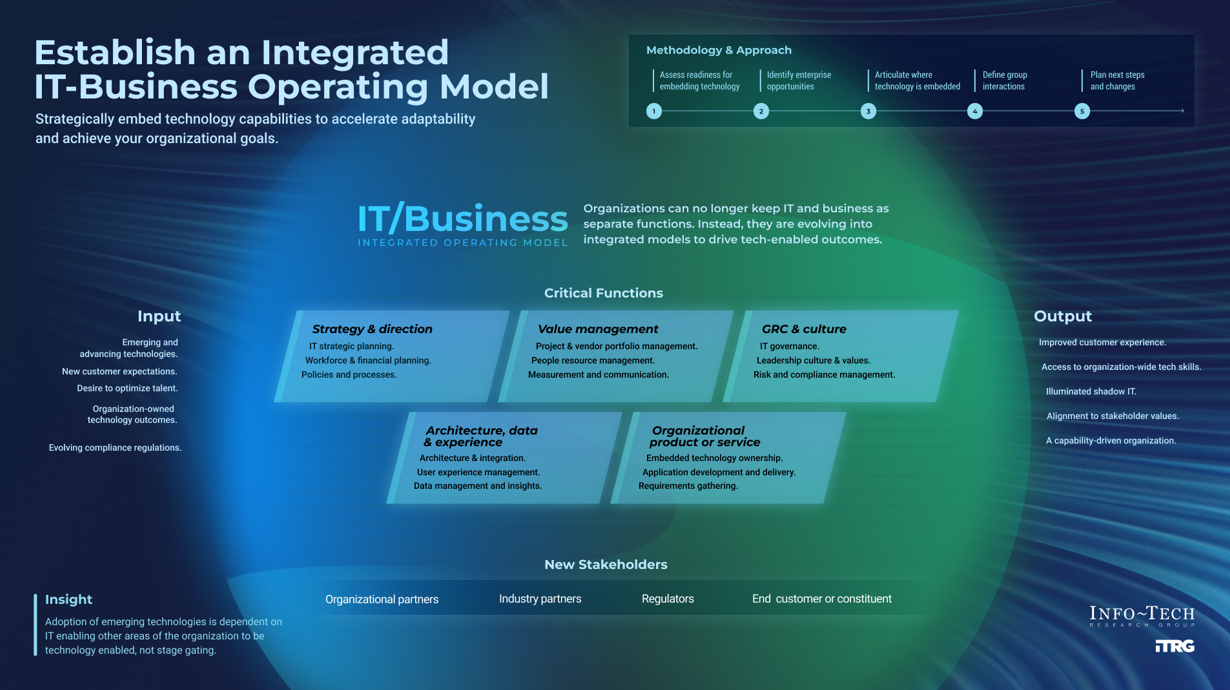
Architect how you will deliver against strategic objectives of the organization
A capability is more than just a person's skills. A capability requires the entire system to satisfy a specific need. This includes people and skills, technology, processes, and measures.
The Elements of an Operating Model:
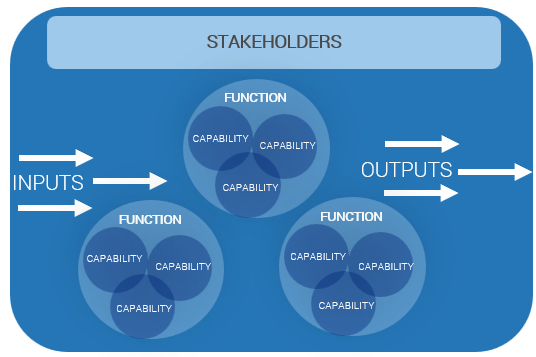
An IT operating model is a visual representation of the way your IT organization will function using a clear and coherent blueprint. This visualization demonstrates how capabilities are organized and aligned to deliver on the business mission and strategic and technological objectives.
Visualization is the optimization and alignment of the IT organization to deliver the capabilities required to achieve business goals. Additionally, it should demonstrate the workflow so key stakeholders can understand where inputs flow in and outputs flow out of the IT organization. Investing time in the front-end to get the operating model right is critical. This will give you a framework to rationalize future organizational changes, allowing you to be more iterative and your model to change as the business changes.
Using a value stream approach creates greater opportunities for organizational integration
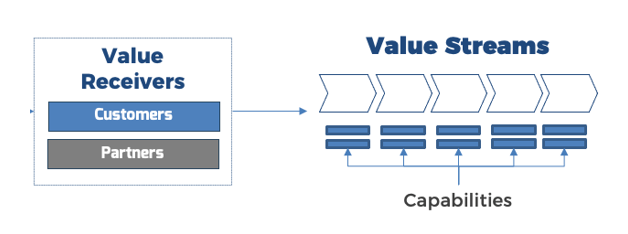
Value streams connect business goals to the organization's value realization activities. They enable an organization to create and capture value in the marketplace by engaging in a set of interconnected activities. Those activities are dependent on the specific industry segment an organization operates within. Value streams can extend beyond the organization into the supporting ecosystem, whereas business processes are contained within, ensuring the organization has complete control over them.
- It is in these core business processes that you need to identify how and where IT capabilities could be embedded to help drive value realization.
- Moreover, we are going to see how these activities grow more interconnected with technology in the coming years as organizations' value streams are forced to reimagine a new experience for customers, partners, or constituents alike.
Purposeful embedding of technology capabilities is not shadow IT
In 2024, we saw a stark 11% growth in the number of organizational stakeholders who indicated that they were engaging in shadow IT without the involvement of IT (Info-Tech's CIO Business Vision). Shadow IT is unsanctioned IT activity that can open the organization up to unexpected risks. It is often discovered by the IT team when they are following up on help desk tickets for unauthorized products or renewal requests from business users or vendors. This is unsanctioned IT activity in the organization that can open the organization up to unwanted risks.
However, when we embed IT, we are purposefully selecting which IT capabilities can and should be owned by the different organizational functions.
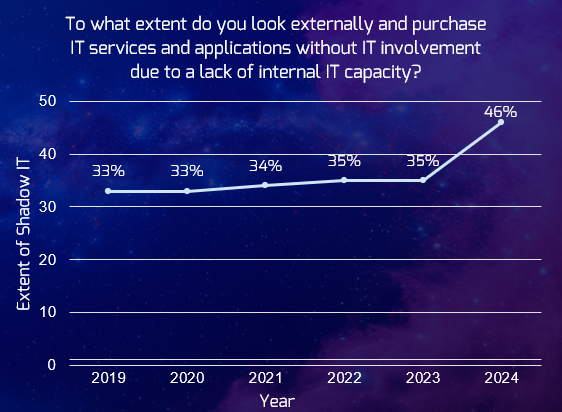
Source: Info-Tech's CIO Business Vision Survey, 2019-2024; N=1,971
Info-Tech's methodology for embedding technology delivery for organization success
| 1. Assess readiness for embedding technology capabilities | 2. Identify enterprise opportunities to embed technology delivery | 3. Articulate where technology capabilities are embedded | 4. Define the engagement model for effective delivery | 5. Identify next steps and changes | |
|---|---|---|---|---|---|
| Step Activities |
|
|
|
|
|
| Step Outcomes | Assess technology's role in driving organizational outcomes and determine if an embedded technology model is the right fit for your organization to pursue. | Define when and where technology capabilities should be embedded at the enterprise level to enable increased value delivery. | To visually depict where IT capabilities will be rooted throughout the organization to enable enhanced delivery and experiences. | Refine the visualized operating model and clarify how each function will interact with other functions and the necessary inputs and outputs to make them successful. | A clear and transparent method of communicating the changes to executive leadership and action plans to achieve. |
Insight summary
Establish a way to drive the innovation culture.
The daily interactions and ways of operating in an organization will reinforce the innovative and forward-looking culture more than any vision or mission statement an organization defines.
Assess everyone's readiness for a new way of operating.
Assuming readiness to adopt an integrated model to enable technology delivery will be the surest way to fail. Get organization-wide leadership to confirm the whole organization, including IT, can make the shift.
Actively determine how the organization will manage technology delivery.
Embedding technology capabilities into the organization must be purposeful. Both the IT leader and organization leader need to understand the shift in accountabilities that will come by undergoing this type of shift.
Set organizational leaders up for success.
Organizational leaders who suddenly "own" technology capabilities might be unsure of when and where they will still need to integrate with the central IT organization.
Align to customer value chains.
Leveraging your reference architecture provides insight into when and where customers obtain the greatest value from your organization – highlighting the greatest opportunities to embed technology.
Phased changes will ensure success.
When making the shift, establish a six to twelve month change plan which will allow people to get comfortable with their new ways of working.
Blueprint deliverables
Each step of this blueprint is accompanied by supporting deliverables to help you accomplish your goals:
Tech-Enabled Organization Playbook
Provide IT and organization leadership with next steps and how to successfully function in the new model.
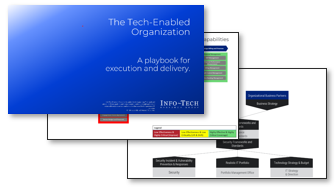
Tech-Enabled Organization Readiness Assessment
Determine the organization's readiness to adopt an embedded technology model and constraints.
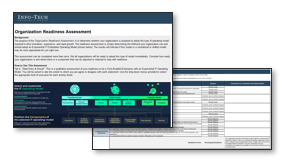
Key deliverable:
Executive Presentation
Communicate to organizational leadership with ease why and how the organization will become more tech enabled.
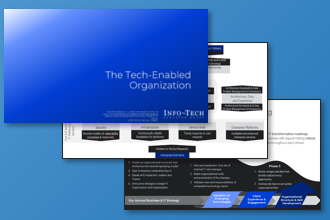
Blueprint benefits
| IT Benefits | Organization Benefits |
|---|---|
|
|
The value of enabling technology delivery throughout the organization
Spend less money and time, while getting exceptional results the Info-Tech Research Group way:
- Reduced time: 6+ months > 3 months or less
- Reduced cost: $200K consulting engagement > included in membership
- Increased value: Neutral satisfaction > exceptional satisfaction
| Value Outcomes | Measurement |
| Increase technology skill adoption | Level of technology skill competency within organization |
| Increase end-customer or constituent satisfaction | End-customer or constituent satisfaction |
| Establish a good service or product portfolio mix | Service or product usage |
| Reduce time to respond to organizational needs | Response time to address needs |
| Enable the organization to say "yes" to more worthwhile technology-driven initiatives |

 Navigate the Digital ID Ecosystem to Enhance Customer Experience
Navigate the Digital ID Ecosystem to Enhance Customer Experience
 Document Business Goals and Capabilities for Your IT Strategy
Document Business Goals and Capabilities for Your IT Strategy
 Build a Business-Aligned IT Strategy
Build a Business-Aligned IT Strategy
 Define Your Digital Business Strategy
Define Your Digital Business Strategy
 Drive Digital Transformation With Platform Strategies
Drive Digital Transformation With Platform Strategies
 Make IT a Partner in Successful M&A Due Diligence
Make IT a Partner in Successful M&A Due Diligence
 Make IT a Successful Partner in M&A Integration
Make IT a Successful Partner in M&A Integration
 Plan Your Digital Transformation on a Page
Plan Your Digital Transformation on a Page
 Review Your Application Strategy
Review Your Application Strategy
 Start Making Data-Driven People Decisions
Start Making Data-Driven People Decisions
 2021 CIO Priorities Report
2021 CIO Priorities Report
 Create a Work-From-Anywhere Strategy
Create a Work-From-Anywhere Strategy
 Mergers & Acquisitions: The Sell Blueprint
Mergers & Acquisitions: The Sell Blueprint
 Mergers & Acquisitions: The Buy Blueprint
Mergers & Acquisitions: The Buy Blueprint
 CIO Priorities 2023
CIO Priorities 2023
 Communicate Any IT Initiative
Communicate Any IT Initiative
 Effective IT Communications
Effective IT Communications
 Establish an Integrated IT-Business Operating Model
Establish an Integrated IT-Business Operating Model
 Info-Tech Quarterly Research Agenda Outcomes Q2/Q3 2023
Info-Tech Quarterly Research Agenda Outcomes Q2/Q3 2023
 Business Vision Diagnostic – Annual IT Improvement Program
Business Vision Diagnostic – Annual IT Improvement Program
 Establish Your Digital Transformation Governance
Establish Your Digital Transformation Governance
 Info-Tech Quarterly Research Agenda Outcomes Q4 2023
Info-Tech Quarterly Research Agenda Outcomes Q4 2023
 Master Your Change Story for Digital Transformation
Master Your Change Story for Digital Transformation
 Info-Tech’s Best of 2023: The Year IT Reached an Inflection Point
Info-Tech’s Best of 2023: The Year IT Reached an Inflection Point
 Prepare for AI Regulation
Prepare for AI Regulation
 Crack the Code to Successful Transformation Management
Crack the Code to Successful Transformation Management
 Info-Tech Diagnostics: Identify and Leverage Your Strengths
Info-Tech Diagnostics: Identify and Leverage Your Strengths
 The CIO Playbook: 8 Secrets and 12 Steps to Systematically Achieve IT Excellence
The CIO Playbook: 8 Secrets and 12 Steps to Systematically Achieve IT Excellence
 Develop an M&A IT Playbook
Develop an M&A IT Playbook
 Adapt to Uncertainty With a Technology-First Action Plan
Adapt to Uncertainty With a Technology-First Action Plan
 Digital Transformation: A Revolution That Lost Its Way
Digital Transformation: A Revolution That Lost Its Way
 The CIO Playbook
The CIO Playbook
 The Essential IT Playbook
The Essential IT Playbook
 Visualize the Industry of the Future
Visualize the Industry of the Future